Ralph Adams Cram
About Andrew Cusack
 Writer, web designer, etc.; born in New York; educated in Argentina, Scotland, and South Africa; now based in London.
Writer, web designer, etc.; born in New York; educated in Argentina, Scotland, and South Africa; now based in London. read more
News
Blogs
Reviews & Periodicals
Arts & Design
World
France
Mitteleuropa
Knickerbockers
Argentina
The Levant
Africa
Cape of Good Hope
Netherlands
Scandinavia
Québec
India
Muscovy
Germany
Academica
‘Solving’ Middle Europe
Ralph Adams Cram’s First-World-War Plan for Redrawing Borders
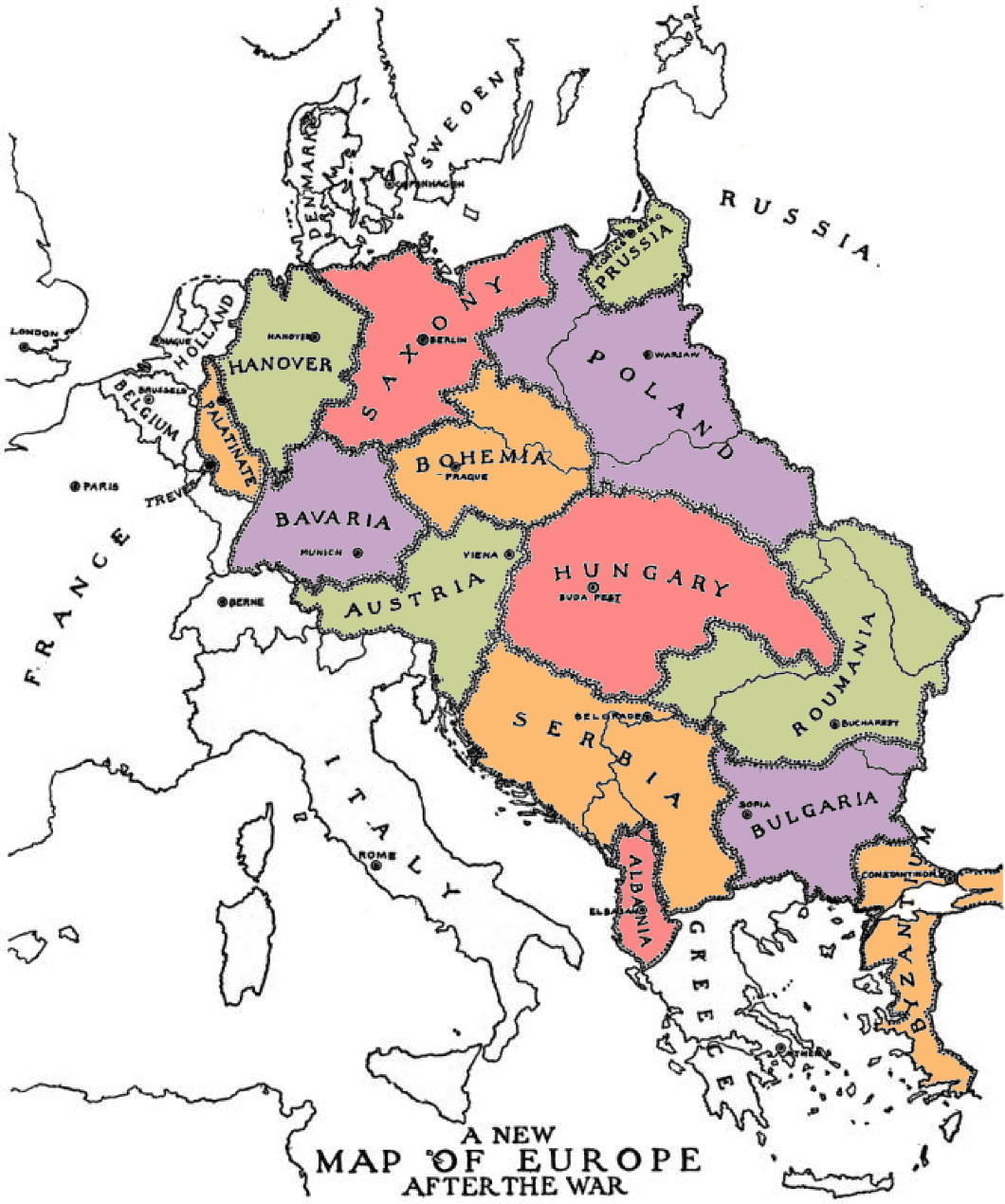
Ralph Adams Cram was not just one of the most influential American architects of the first half of the twentieth century: he was a rounded intellectual who expressed his thinking in fiction, essays, and books in addition to the buildings he designed.
Cram (and arguably even more his business partner Goodhue) had a gift for bringing the medieval to life in a way that was neither archaic nor anachronistic but instead conveyed the gothic (and other styles) as living, organic traditions into which it was perfectly legitimate for moderns to dwell, dabble, and imbibe.
His literary efforts include strange works of fiction admired by Lovecraft and political writings inviting America to become a monarchy. These have value, but it’s entirely justifiable that Cram is best known for his architectural contributions.
All the same, amidst the clamours of the First World War this architect of buildings played the architect of peoples and sketched out his idea of what Europe after the war — presuming the defeat of the Central Powers — would look like.
In A Plan for the Settlement of Middle Europe: Partition Without Annexation, Cram set out his model for the territorial redivision of central and eastern Europe “to anticipate an ending consonant with righteousness, and to consider what must be done… forever to prevent this sort of thing happening again”.
Cram, who provided a map as a general guide, predicted the return of Alsace-Lorraine to France, Schleswig-Holstein to Denmark, the Trentino and Trieste to Italy, much of Transylvania to Romania, Posen to a restored Poland, and Silesia divided in three.
Fundamental to the architect’s thinking was that “neither Germany, Austria-Hungary, nor Turkey can be permitted to exist as integral or even potential empires”. Austria and Hungary would be split and Germany needed to be partitioned (not, as some later plans had it, annexed). (more…)
Monday 18 January

– Architectural historian Catesby Leigh looks at Ralph Adams Cram and Pittsburgh’s gothic architectural legacy.
– In October for the first time ever Polish voters handed a parliamentary majority to a single party, putting the Law and Justice (PiS) party in power after nine years in opposition. But, alarmed by the new government’s attempts to correct the stacking of state media by their political opponents, western European powers have attacked the new government and suggested it be investigated by the European Union.
The PiS delegation of the European Conservatives & Reformists Group in the European Parliament has released a measured statement asking What is really happening in Poland? Given recent events in Cologne, however, Polish fans at a volleyball match in Berlin viscerally suggested the Germans should get their own act in order before criticisng others.
– Polish academic Artur Rosman explores both the history and future of the pro-life movement in America, citing the New York Times’s Kristen Dombek’s surprise at discovering that abortion is not an exclusively conservative concern:
Among those of us who wish to protect access to abortion, it’s easy to feel that “right to life” language is a cover for an attack on feminism. It’s a feeling supported by a common story about history: The anti-abortion movement began after Roe v. Wade, because conservative evangelicals were threatened by women’s newfound power over their bodies. What else could explain the movement’s swift rise in the decade following the Supreme Court’s decision, if not a widespread reaction against equal rights? […]
[I]t’s hard to imagine a country where the most prominent voices against abortion were Catholic physicians, and evangelical Protestants were either in favor of lifting restrictions on abortion, or didn’t really care. A country where Democrats and the Black Panthers opposed abortion, and Ronald Reagan, like most conservatives, supported it. Where more men than women supported legalizing abortion, and Hugh Hefner was one of those men, leading one activist to call legalized abortion the “final victory of the Playboy philosophy.” Where opposition to abortion found common cause with opposition to the exploitation of women, to the abandonment of the poor, to big business and to the Vietnam War.
– And finally, Sam the Eagle has a message for all the prospective candidates in the American presidential election:
An Aldermanian Skyscraper
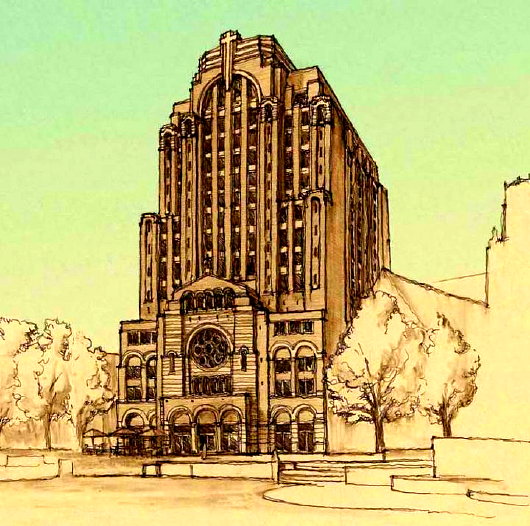
Good news from the Middle West: the Catholic chaplaincy at the University of Wisconsin at Madison announced plans for multi-use, high-rise structure in the city built in a traditional style. Matthew Alderman Studios served as the principal designer for the elevations of the St. Paul University Catholic Center, a 14-storey, $45-million structure in a Romanesque-Deco style that will include a chapel, meeting rooms, and student housing.
“Catholic life in Madison has undergone a remarkable renaissance under Bishop Morlino,” Matt Alderman says, “and St. Paul’s is one of the foundations of this resurgence. I can assert from personal experience that it is really heartening what is going on over there. St. Paul’s is molding a new generation of faithful, responsible, and joyfully serious young Catholics.”
Matt noted that the concept for the St. Paul Center is reminiscent of the skyscraper-church designs mooted during the first half of the twentieth century. In most of those proposals, however, the skyscraper factor tended to overwhelm the ecclesiastical visuality of the overall design. Matt has deftly avoided this in the St. Paul plans: from the perspective of the man on the street, the most prominent part of the façade is obviously ecclesiastical, and the many storeys above flow naturally, but unobtrusively, therefrom.
“It was important to impart an ecclesiastical character to the principal facade while at the same time asserting the building’s mixed-use status. In my own sketches, I drew on the work of Ralph Adams Cram at Christ Church Methodist in New York, a rugged urban ecclesiastical plant with a great deal of dignity and personality, and Bertram Goodhue’s slightly earlier St. Bartholomew’s, just down the street on Park Avenue.”
RDG Design and Planning of Omaha acted as principal architects of record. Matt Alderman is not yet an architect officially — the certification process in America is wisely prolonged — but as a design consultant he’s already serving up enough to whet our appetite. Diocesan chancelleries, parish boards, heck, anyone who wants to build anything: keep this guy in mind!
Unbuilt St. Thomas
Lord & Hewlett’s Competition Entry for the Church of St. Thomas
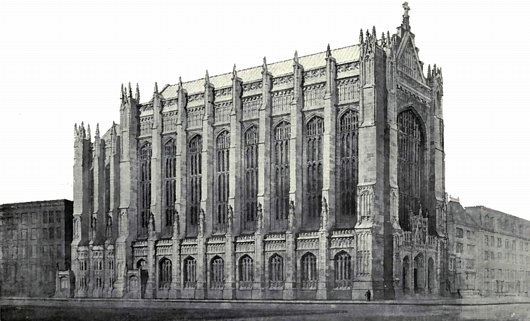
THE CHURCH OF Saint Thomas on the corner of Fifty-third Street and Fifth Avenue in New York is one of the artistic gems of the city: both as an architectural marvel designed by Ralph Adams Cram & Bertram Grosvenor Goodhue and as a musical paradise with its renowned choir of men & boys formerly under the tutelage of Gerre Hancock. (It’s foolish for anyone in the city during Advent to miss the Service of Lessons & Carols). The parish of the Episcopal Diocese of New York was established in 1834, and its first building was erected in the Gothic style on the corner of Broadway and Houston.
In 1870, after that neck of the woods became less fashionable, the congregation moved to its current location at 53rd & Fifth, to a new Gothic edifice by Richard Upjohn. That church hosted the marriage of Consuelo Vanderbilt to the 9th Duke of Marlborough. When it burned down in 1905, a competition was held to select the design of the new Church of St. Thomas, then perhaps at the peak of its high social status among Manhattan’s Protestant congregations. (more…)
Novanglian Peregrinations
A journey to the shining city of Saint Botolph, and return
THE PERIOD OF MY removal to South Africa sometimes inclines me to think that time stood still during my absence from the northern hemisphere. It is as if the mental chronicle of my brain simply ceased, and took up writing in a different book, and then went back to the end of the old page upon my return. But time indeed did pass, and many were the old friends and acquaintances with whom we had not combined in some time. Communication was no better than intermittent while exiled in southerly climes, but, freshly returned, the tom-toms were beat and the smoke signals sent to the usual suspicious characters of note. A convocation of cohorts and old confederates was then proposed, to take place in Boston — caput and urbs maxima of God’s own province of New England.
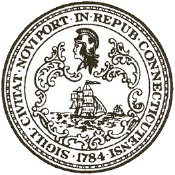 My first stop was actually New Haven, and traversing the border into Connecticut I crossed myself in accordance with ancient custom, invoking the guardian angel of that jurisdiction in the usual pleas for safe travel, easy passage, and the avoidance of traffic cops & parking fines. In New Haven, I attended the meeting of a learned society (composed of both postgraduates & undergraduates) devoted to polite discourse, under the sacred patronage of the Saints Augustine of Hippo and of Canterbury, and the secular patronage of the Anglo-Irish divine Bishop Berkeley. Speaking of the divine, the society’s meeting was preceded by Mass, offered by one of the Dominicans who unofficially tend to the flock of Yale students (the official Roman chaplaincy there having a poor reputation) in an improvised chapel at the club’s quarters.
My first stop was actually New Haven, and traversing the border into Connecticut I crossed myself in accordance with ancient custom, invoking the guardian angel of that jurisdiction in the usual pleas for safe travel, easy passage, and the avoidance of traffic cops & parking fines. In New Haven, I attended the meeting of a learned society (composed of both postgraduates & undergraduates) devoted to polite discourse, under the sacred patronage of the Saints Augustine of Hippo and of Canterbury, and the secular patronage of the Anglo-Irish divine Bishop Berkeley. Speaking of the divine, the society’s meeting was preceded by Mass, offered by one of the Dominicans who unofficially tend to the flock of Yale students (the official Roman chaplaincy there having a poor reputation) in an improvised chapel at the club’s quarters.
Mass was followed by port, smoking, and some cheese & finger foods for the hungry souls. I mentioned to a friend that the Choco-Leibniz cookies on offer were my favourite, the official state biscuit of the house of Cusack. “Of course they are,” the wag responded. “Choco-Leibniz are the best of all possible biscuits!” (Some jokes are so bad that the resulting chortles are both inevitable and involuntary.)
Then, the subject at hand. This meeting was convened to discuss the recently announced Apostolic Constitution establishing “personal ordinariates” to ease the reception of Anglican Christians into full visible communion with the Pope. The assembled members were by no means only Catholics, but with a significant portion of Episcopalians, and the odd Calvinist for good measure. A brief paper by an entrenched Anglican was read, and the members responded and discussed the matter with courtesy and depth as the fire crackled in the background. Which groups are likely to take advantage of the coming ordinariates? Which are least likely? Was this chiefly a pastoral move? What do the Orthodox think? What will the reaction be outside North America? All these questions and many, many more were raised and, so far as possible, answered.
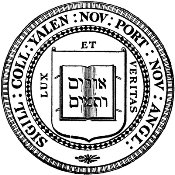 The formal discussion was concluded with the invocation of the two Augustines and a toast to Bishop Berkeley. A number of members remained by the fire while others dispersed for other events. The weekend beheld the 75th Anniversary of the Yale Political Union, and so the constituent parties of the YPU were all having events for their members and alumni. (From what I can understand of the YPU’s right-leaning parties, the Conservative Party is for Republicans, the Tory Party is for decadent Anglophiles, and the Party of the Right is for conservatives.)
The formal discussion was concluded with the invocation of the two Augustines and a toast to Bishop Berkeley. A number of members remained by the fire while others dispersed for other events. The weekend beheld the 75th Anniversary of the Yale Political Union, and so the constituent parties of the YPU were all having events for their members and alumni. (From what I can understand of the YPU’s right-leaning parties, the Conservative Party is for Republicans, the Tory Party is for decadent Anglophiles, and the Party of the Right is for conservatives.)
Following the procurement of beer and the ordering of pizza, the consumption of both, and the extinguishing of the fire, it was time to retreat for the evening to the splendid old Victorian house where a number of folks live. It’s one of those old, solidly American homes, with a swinging chair on the porch, splendid wood detailing inside, and pocket doors between the receiving rooms. Dotted around an old dining room table, more news and rumours were exchanged between the inhabitants and guests as the remnants of a bottle of Macallan was polished off. The Choco-Leibniz joke was repeated for those who were not in attendance before. A South Carolinian’s reaction to the health-food movement was recalled: “They won’t buy an egg if it ain’t free-range but they put on all manner of uh-koo-tra-mints so as not to conceive!” One of our friends, an Englishman, treated us to a rendition of “Come Thou Font of Every Blessing” on the banjo, and we were informed that a group of Yale Divinity students were officially reprimanded for having a watermelon-eating competition. (Watermelons often feature in stereotypical caricatures of American Blacks, and thus are apparently forbidden by the Monotony Monitors). We went on in such manner until the wee hours, when the assembled finally adjourned to bed.
Then the morning: breakfast — pumpkin pancakes from S.O.’s wife before she popped off to riding practice — before A.L. and I combined to continue the journey onwards to the City of Saint Botolph, Boston. The city’s name comes from the Lincolnshire town of Boston, itself a contraction of “Saint Botolph’s Town”. Many of the Puritans hailed from the East Midlands, and it was John Cotton, the controversial Vicar of Saint Botolph’s Church in Boston, who encouraged many separatist radicals to emigrate to the Massachusetts Bay Colony in New England. The New-World town of Boston was founded in 1630, and named in honor of the place associated with Cotton, who himself emigrated three years later. The Church of Saint Botolph is the most prominent landmark of old Boston, founded in 1309 and famous for its late-fifteenth-century English Perpendicular lantern tower. As coincidences go, the design of Harkness Tower at Yale University in New Haven is inspired by that of Saint Botolph’s in old Boston. New Haven’s name also harks back to the River Haven which flows just some thirty-odd feet from the great tower of Saint Botolph.
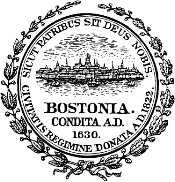 A New Yorker is always of two minds about Boston. We consider it a somewhat uppity member of our northern periphery and despise the attitude of some of its lowlier inhabitants (the sporting fans of red hosiery), but the old Knickerbocker can’t help but envy the skill and ability with which the Bostonians have preserved so much that has been utterly destroyed in New York. Boston, despite its politics, might just be the most conservative town in the American Republic. During our stay in Boston, we never left the immediate vicinity of Beacon Hill and Back Bay, except for one foray into Chinatown for dinner. The architecture is splendid, traditional, and vernacular, and the streets are uncrowded compared to the vast hordes that swarm around Manhattan.
A New Yorker is always of two minds about Boston. We consider it a somewhat uppity member of our northern periphery and despise the attitude of some of its lowlier inhabitants (the sporting fans of red hosiery), but the old Knickerbocker can’t help but envy the skill and ability with which the Bostonians have preserved so much that has been utterly destroyed in New York. Boston, despite its politics, might just be the most conservative town in the American Republic. During our stay in Boston, we never left the immediate vicinity of Beacon Hill and Back Bay, except for one foray into Chinatown for dinner. The architecture is splendid, traditional, and vernacular, and the streets are uncrowded compared to the vast hordes that swarm around Manhattan.
Our home for the time being was a handsome apartment in Beacon Hill, well-decorated and amply supplied with books and booze. A.L. and I parked the car in the garage under Boston Common, and were met by our close friend I.M.C., who is the lynchpin uniting this social circle. I.M.C. hails from north of Boston, towards Gloucester, but had arranged for his friend T.L.G. to host us in his flat overlooking the Public Garden. Upon arriving we were offered generous cups of tea, ginger snaps, and sliced mango and conversed for quite some time before we decided upon a light Saturday afternoon jaunt around Back Bay and Beacon Hill.
T.L.G. explained the creation of Back Bay from landfill as the four of us swaggered down Commonwealth Avenue, be-tweeded on this autumn day. We popped into the Boston Public Library just before closing, and gazed out onto Copley Square that was once the epicenter of the city. The square is or was, at various times, home to the Public Library, Old South Church (Cong.), Trinity Church (Episc.), the Massachusetts Institute of Technology, the Museum of Fine Arts, and the Copley Plaza Hotel. Sadly, it is now disfigured by the looming bulk of the John Hancock Tower, a modern skyscraper by I. M. Pei that is the tallest building in New England. It was so shoddily constructed that entire panes of glass began to fall off after it was completed, eventually forcing the owners to replace ever single pane of glass within just a few years. We swung by the Church of the Advent where our host is a parishioner and whose Lady Chapel and rood cross were designed by Ralph Adams Cram. Just after we exited the Church, we were introduced to the Rector, who was just coming home from the wine shop.
Returning to the apartment, it was time for drinks. The gin flowed like wine, and it wasn’t long before we were joined by J.T., A.R., and M.D. All manner of things under Heaven were discussed, from the latest exploits of mutual friends, to matters of state, and of course church affairs (this is a half-papist, half-’piskie crowd). Said discussions continued around a table for seven at the Taiwan Café in Boston’s Chinatown. (Good to support Nationalist China, but it did require crossing Boston in the rain). Our dinner of pork, dumplings aplenty, soup, and tea finished, we progressed to a certain private club for more drinks. M.D. treated us to his side-splitting imitation of Katharine Jefferts Schori and Peter Akinola having an argument before the evening finally came to it’s conclusion.
Sunday morning, breakfast of tea, sausages, and proper porridge. Despite all the previous evening’s drinks, not so much as a hint of a hangover. Stood on the balcony overlooking Charles Street in the unseasonable warmth and began to appreciate Boston’s existence. I.M.C. cordially invited us to visit his home town of Beverly, a good New England town north of Boston and on the sea. Lunch, evening Mass, dinner, more good conversation throughout. But an early morning’s rise on Monday, to make it back south home to New York, ending a fine and invigorating peregrination through at least part of New England.
Calatrava’s St. John the Divine
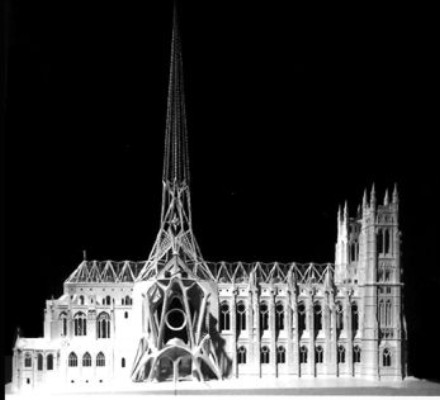
I’ve always somewhat admired Santiago Calatrava’s plan for the completion of the (Episcopalian) Cathedral of St. John the Divine here in New York. It was commissioned in the 1980’s by the über-dodgy Rev. James Parks Morton, dean of the Cathedral at the time. Morton was responsible for turning “St. John the Unfinished” into the hippie-trippy-ecumenical-syncretist-pagan-temple-cum-performing-arts-center it is known as today, and came up with this scheme to try to bring the cathedral to completion. (The plan has since been abandoned and all construction ceased a decade ago; scaffolding remains because the cost of removing it was judged to be too high).
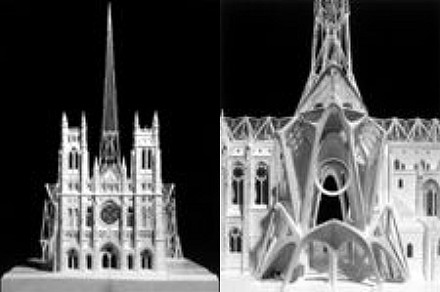
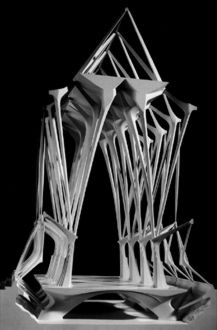 The plan involved a ‘biosphere’ garden being planted atop the nave in the giant greenhouse formed by Calatrava’s lithely arches. Though I much prefer the crossing tower in the design by Ralph Adams Cram, I still think that Calatrava’s plan is rather exciting. It only succeeds, however, because Cram and (Heins & Lafarge before him) laid an ample beautiful foundation (well, obviously quite much more than that) for Calatrava to complete. The cathedrals which Signor Calatrava has designed completely himself have been completey devoid of aesthetic appeal, as well as conceived outside of the millenia-long tradition of church architecture.
The plan involved a ‘biosphere’ garden being planted atop the nave in the giant greenhouse formed by Calatrava’s lithely arches. Though I much prefer the crossing tower in the design by Ralph Adams Cram, I still think that Calatrava’s plan is rather exciting. It only succeeds, however, because Cram and (Heins & Lafarge before him) laid an ample beautiful foundation (well, obviously quite much more than that) for Calatrava to complete. The cathedrals which Signor Calatrava has designed completely himself have been completey devoid of aesthetic appeal, as well as conceived outside of the millenia-long tradition of church architecture.
The (Catholic) Diocese of Oakland commissioned Calatrava to design their new ‘Cathedral of Christ the Light’ after the old seat was greatly damaged in an earthquake. Despite the vacuousness of the design (model below), Signor Calatrava proved to be outside the Diocese’s budget, and his second-rate design was shelved and replaced with a third-rate design of a vaguely similar ilk. The third-rate design is the one which will be built, though a first-rate proposal in the vernacular style natural to California has been drawn up by Mr. Domiane Forte. Methinks Signor Calatrava should stick to his catchy bridges.
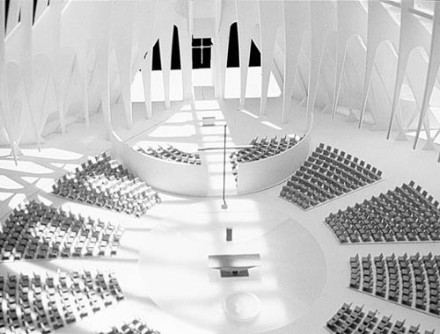
Search
Instagram: @andcusack
Click here for my Instagram photos.Most Recent Posts
- Bicycle Rack April 29, 2024
- Burns Tower April 19, 2024
- Patrick in Parliament March 18, 2024
- Articles of Note: 13 March 2024 March 13, 2024
- Cambridge March 9, 2024
Most Recent Comments
Book Wishlist
Monthly Archives
Categories


